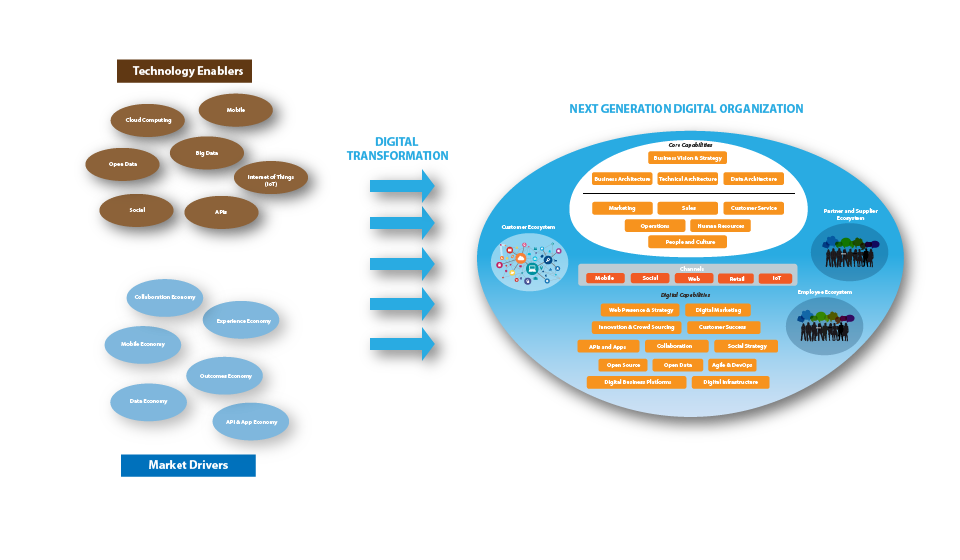Researchers report that more data has been created in the last two years than in all of human history, and market research firm IDC notes in 2014, the digital universe equaled 1.7 megabytes a minute for every person on Earth. IDC predicts the total size of the digital universe will reach 44 zettabytes of data in 2020. Roughly 10 percent of that data will come from 32 billion connected devices—more than twice as many as there are now.
With the influx of large amounts of data from multiple traditional and modern channels, advances in processing power, lowering of barriers in processing large data sets, reduction in cost of storage and advances in data science organizations are able to leverage software/machines to help them make more informed decisions. In this deeply data driven model, organizations can readily exploit actionable insights from data to drive better business outcomes across the enterprise.
Big data analytics combined with the proliferation of mobile and wearable devices are allowing businesses to craft experiences that are unique and personalized to each user. Personalized, unified User experience across multiple channels (web, mobile, wearables, connected cars, connected homes and other smart objects) is key to engage consumers and gain competitive advantage.
All types of businesses, not just technology companies are using personalization to provide context rich experiences to the consumer. This means all features and functionality built into any product must reflect what individuals are trying to accomplish, enabling them to control and automate parts of their lives in both physical and digital worlds. Customer demand for outcome based, personalized, integrated experience is driving innovation towards solutions than products. Organizations can gain quantifiable, end to end insights into the outcomes their customers are trying to achieve and use those insights to develop significantly more effective solutions.
It is estimated that 50 billion devices connected to the internet by 2020 (source:Cisco) with a total potential economic impact in the order of $4Trillion to $14 Trillion across all industries by 2025 (Source: McKinsey, Cisco). Internet of Connected Things has the potential to fundamentally shift the way we interact with our surroundings. The ability to monitor and manage objects in the physical world electronically makes it possible to bring data-driven decision making to new realms of human activity—to optimize the performance of systems and processes, save time for people and businesses, and improve quality of life.
With 5.2B mobile users across the world (source:Internet Trends 2015, KPCB.com), Mobile has become the new de-facto access point and combined with Cloud computing has led to true ubiquitous computing. The processing power of the average smartphone has increased by about 25 percent per year over the past five years, and the latest processors can adeptly juggle multiple resource-intensive applications and produce vivid graphics. The mobile Internet is also being offered in entirely new formats, such as wearable devices. In coming years, mobile Internet devices will be smaller, far more powerful, more intuitive, wearable, and packed with many types of sensors.
Software is eating the world and every business is being forced to become a software business. As more products become smart and connected, software is emerging as the connective tissue for value creation, even for companies that sell physical goods. Intelligent applications are a playing critical role in driving business decisions across all types of businesses influencing how these businesses interact with their customers, how they buy and sell products or services and how they find their next product insights.
Furthermore, innovations in technologies such as Machine Learning, Natural Language Processing, and Cognitive Computing are changing the way consumer and enterprise software is developed. These technologies, in conjunction with new user interface formats such as gesture, touch and voice, are opening a new world of possibilities for software developers. Modern software is smarter, connected, mobile-friendly, cloud operated, social aware, API based and user focused.
However, to compete with agility and speed, companies can no longer afford complex, lengthy and expensive coding of applications, or massive, multi-year system implementations. What’s needed is a new way to build software—faster, flexible and more agile—with reusable components that allow for rapid assembly of applications in support of dynamic business needs. This approach requires an Agile approach to development, DevOps culture, modular and micro-service based architectures, next-generation integration techniques and a cloud-first, mobile-first and API-first mindset.
We believe that in order to get ahead in todays hyper-connected digital world, every business needs to become a digital business with the appropriate tools, processes, mechanisms and digital channels in place to reach the customer, all aligned to a business strategy focused on customer experience and agility. All layers of a traditional business including marketing, management, employee engagement, customer acquisition, infrastructure, must be evaluated and transformed to meet the challenges of the digital world. The traditional approach of let’s define a “target state” and create a “roadmap” to get there does not work any more. Organizations need a transformation strategy that is rooted in incremental, iterative, agile transformation with a firm focus on measurable results – the “target state” will continue to evolve influenced by changing business conditions, customer behavior and technological innovation. An ideal transformation effort will consider all these factors and lay out a roadmap that addresses the question – “where do I start and how do I become agile enough to be able to react to changing market conditions”.

